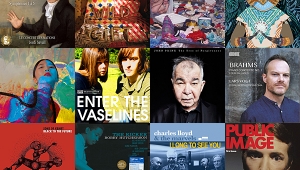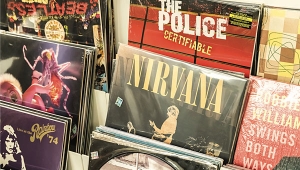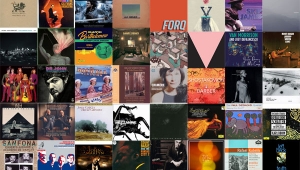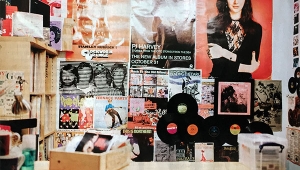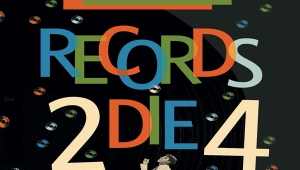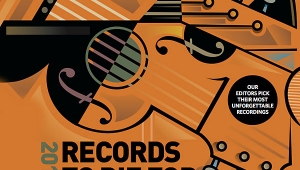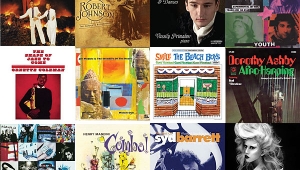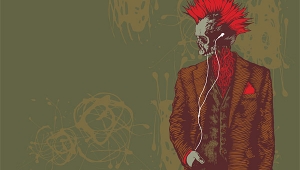| Columns Retired Columns & Blogs |
2000 Records to Die For Page 3
Les Berkley
FAIRPORT CONVENTION: Babbacombe Lee
A&M SP 4333 (LP), Island ILPS 9176 (LP). 1972/1995. John M. Wood, prod., eng.; Simon Nicol, prod. AAA.
1999 was a bad year for the arts in general. Many things threatened the very foundations of creative endeavor: left-wing deconstructionists, right-wing religionists, and, of course, Thomas Kinkade, The Painter of Light®. Despite this, and the more serious threat posed by competing media and nanosecond attention spans, the good stuff continues to endure.
BETTY CARTER: Inside Betty Carter
Betty Carter, vocals; Harold Mabern, piano; Bob Cranshaw, bass; Roy McCurdy, drums United Artists 5639 (LP). 1964/1972/1993. Alan Douglas, prod.; Bill Schwartau, eng. AAA. TT: 25:43
Although she launched her career in the '40s, it was not until the decade before her death in 1998 that Betty Carter was fully recognized as a premier jazz diva, a musician's musician whose instrument was her voice. This reissue of a 1964 LP (itself reissued on CD in 1993, together with seven previously unreleased tracks from a 1965 session) captures Carter in her early prime, with brighter vocals and milder mannerisms than on her better-known later recordings.
JUNIOR WELLS: Hoodoo Man Blues
Delmark DD-612 (CD). 1965/1990. Robert G. Koester, prod.; Stu Black, eng. AAD. TT: 45:40
This landmark 1965 recording helped introduce a young white audience to a generation of modern electric bluesmen, sparking the blues-rock boom of the late '60s. Two years after Wells' death, Hoodoo Man Blues still stands as one of the finest Chicago blues albums ever, brilliantly showcasing not only Wells' gritty vocals and soulful harmonica, but the icy-cool guitar of his longtime partner, Buddy Guy.
DAVE ALVIN: King of California
Hightone HCD 8054 (CD). 1994. Greg Leisz, prod.; Paul duGré, Joe Peccerillo, engs. AAD? TT: 54:49
Dave Alvin first appeared on the musical landscape as a member of L.A. roots-rockers The Blasters. Although a flashy lead guitarist and the group's primary songwriter, he left the singing duties to brother Phil. (If you had a brother who sang like Phil, you would, too.) Once solo, he had to face the music and sing. Although he's no Phil, his croaky baritone works well with these tails of near-winners and noble losers. This is his "unplugged" album, and even though he can be a roaring rocker, it's nice to have Dave's detail-rich lyrics and precision picking front and center, all the more so because the recording is so damned good. Check out "Barn Burning" and see what I mean. Then put on "Blue Wing" and just try to keep from crying in your beer.
DANIEL LANOIS: Acadie
Opal/Warner Bros. 25969-2 (CD). 1989. Daniel Lanois, prod., eng.; Paul Barrett, Malcolm Burn, Mark Howard, engs. AAD? TT: 41:03
If you've heard of Daniel Lanois at all, most likely it's as a producer (U2, Peter Gabriel, Neville Brothers, Bob Dylan). Surprise! He's also a talented musician, and this was his first solo album. His trademark as a producer is the ability to create a strong aural atmosphere, and here the air is positively thick. Lanois hails from Quebec, and this album was recorded in his studio in New Orleans, so he's got connections to both ends of the Acadian/Cajun continuum that figures so prominently in these songs. He sings sometimes in French, sometimes in English—sometimes both in the same song. The somber tunes are positively spooky, but even the upbeat ones put you just a two-step away from the swamp. There's a mysterious charm to these songs that mere words cannot convey—as Screamin' Jay Hawkins might say, they've put a spell on me. (XIII-1)
FAIRPORT CONVENTION: Babbacombe Lee
A&M SP 4333 (LP), Island ILPS 9176 (LP). 1972/1995. John M. Wood, prod., eng.; Simon Nicol, prod. AAA.
ANONYMOUS 4: 11,000 Virgins
Harmonia Mundi HMU 907200 (CD). 1997. Robina G. Young, prod.; Brad Michel, eng. DDD. TT: 72:07
1999 was a bad year for the arts in general. Many things threatened the very foundations of creative endeavor: left-wing deconstructionists, right-wing religionists, and, of course, Thomas Kinkade, The Painter of Light®. Despite this, and the more serious threat posed by competing media and nanosecond attention spans, the good stuff continues to endure.
Babbacombe Lee was Fairporter Dave Swarbrick's concept album: the story of the celebrated Victorian convict John Lee of Babbacombe. Sentenced to hang for a crime he probably committed, Lee was brought three times to the scaffold, and three times the mechanism failed to work, even though it functioned perfectly without him. Out of his story, Fairport Convention fashioned a moving and beautiful suite of music. I don't think it sold very well—it was probably too far out even for the folk-rock crowd—but I've played it countless times over the last 25 years, and it never fails to catch my interest. The original A&M release had gorgeous gatefold packaging, a long historical account of the original events, and glorious, warm sound. The reissue keeps most of the sound quality, anyway. If you see this at a flea market (I did recently), grab it.
I knew I was going to put an Anonymous 4 recording in this list eventually; the only question was which one. "Go for the virgins!" I told myself, and so I have. 11,000 Virgins is not necessarily the best of Anon 4's efforts, but it's the one I like best, and contains some absolutely stunning versions of works by Hildegard von Bingen that really should be heard. Sound is as good as HM has produced, which puts it right at the top. If you're wondering what all the Anonymous hype is about, this will show you. (XX-10)
![]()
Larry Birnbaum
BETTY CARTER: Inside Betty Carter
Betty Carter, vocals; Harold Mabern, piano; Bob Cranshaw, bass; Roy McCurdy, drums United Artists 5639 (LP). 1964/1972/1993. Alan Douglas, prod.; Bill Schwartau, eng. AAA. TT: 25:43
Although she launched her career in the '40s, it was not until the decade before her death in 1998 that Betty Carter was fully recognized as a premier jazz diva, a musician's musician whose instrument was her voice. This reissue of a 1964 LP (itself reissued on CD in 1993, together with seven previously unreleased tracks from a 1965 session) captures Carter in her early prime, with brighter vocals and milder mannerisms than on her better-known later recordings.
While relatively muted, Carter's stylistic trademarks—elongated syllables, hornlike bends, phrases that rush or lag behind the beat, suddenly soaring or swooping notes—are all on display here as she turns a set of Broadway show tunes into a hypnotic guide to the agonies and ecstasies of romance. Highlights include "My Favorite Things," transformed from a genteel waltz to a breakneck 4/4 gallop, and "Spring Can Really Hang You Up the Most," a stilted ballad reconstructed as an emotional roller-coaster. Mabern, Cranshaw, and McCurdy provide exquisite accompaniment.
JUNIOR WELLS: Hoodoo Man Blues
Delmark DD-612 (CD). 1965/1990. Robert G. Koester, prod.; Stu Black, eng. AAD. TT: 45:40
This landmark 1965 recording helped introduce a young white audience to a generation of modern electric bluesmen, sparking the blues-rock boom of the late '60s. Two years after Wells' death, Hoodoo Man Blues still stands as one of the finest Chicago blues albums ever, brilliantly showcasing not only Wells' gritty vocals and soulful harmonica, but the icy-cool guitar of his longtime partner, Buddy Guy.
Backed by the glove-tight rhythms of bassist Jack Myers and drummer Billy Warren, Wells and Guy demonstrate telepathic empathy on material ranging from Sonny Boy Williamson's "Good Morning Schoolgirl" to Kenny Burrell's "Chitlin Con Carne." Wells chortles, moans, whoops, and growls, with and without his harp, while Guy masterfully combines lead lines and rhythm chords. Although the mood is generally low-key and laid-back, the music sizzles with an intensity not found on shriller, brasher productions. (XIV-1, XXII-2, XIX-12)
![]()
Lonnie Brownell
DAVE ALVIN: King of California
Hightone HCD 8054 (CD). 1994. Greg Leisz, prod.; Paul duGré, Joe Peccerillo, engs. AAD? TT: 54:49
Dave Alvin first appeared on the musical landscape as a member of L.A. roots-rockers The Blasters. Although a flashy lead guitarist and the group's primary songwriter, he left the singing duties to brother Phil. (If you had a brother who sang like Phil, you would, too.) Once solo, he had to face the music and sing. Although he's no Phil, his croaky baritone works well with these tails of near-winners and noble losers. This is his "unplugged" album, and even though he can be a roaring rocker, it's nice to have Dave's detail-rich lyrics and precision picking front and center, all the more so because the recording is so damned good. Check out "Barn Burning" and see what I mean. Then put on "Blue Wing" and just try to keep from crying in your beer.
DANIEL LANOIS: Acadie
Opal/Warner Bros. 25969-2 (CD). 1989. Daniel Lanois, prod., eng.; Paul Barrett, Malcolm Burn, Mark Howard, engs. AAD? TT: 41:03
If you've heard of Daniel Lanois at all, most likely it's as a producer (U2, Peter Gabriel, Neville Brothers, Bob Dylan). Surprise! He's also a talented musician, and this was his first solo album. His trademark as a producer is the ability to create a strong aural atmosphere, and here the air is positively thick. Lanois hails from Quebec, and this album was recorded in his studio in New Orleans, so he's got connections to both ends of the Acadian/Cajun continuum that figures so prominently in these songs. He sings sometimes in French, sometimes in English—sometimes both in the same song. The somber tunes are positively spooky, but even the upbeat ones put you just a two-step away from the swamp. There's a mysterious charm to these songs that mere words cannot convey—as Screamin' Jay Hawkins might say, they've put a spell on me. (XIII-1)
- Log in or register to post comments

